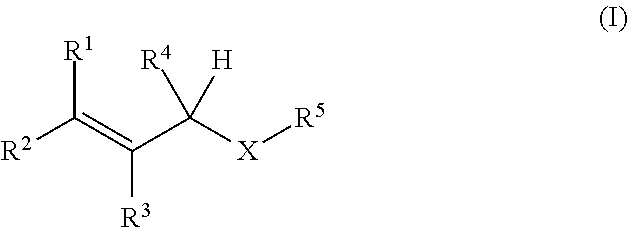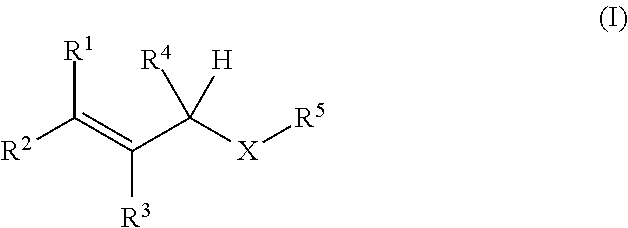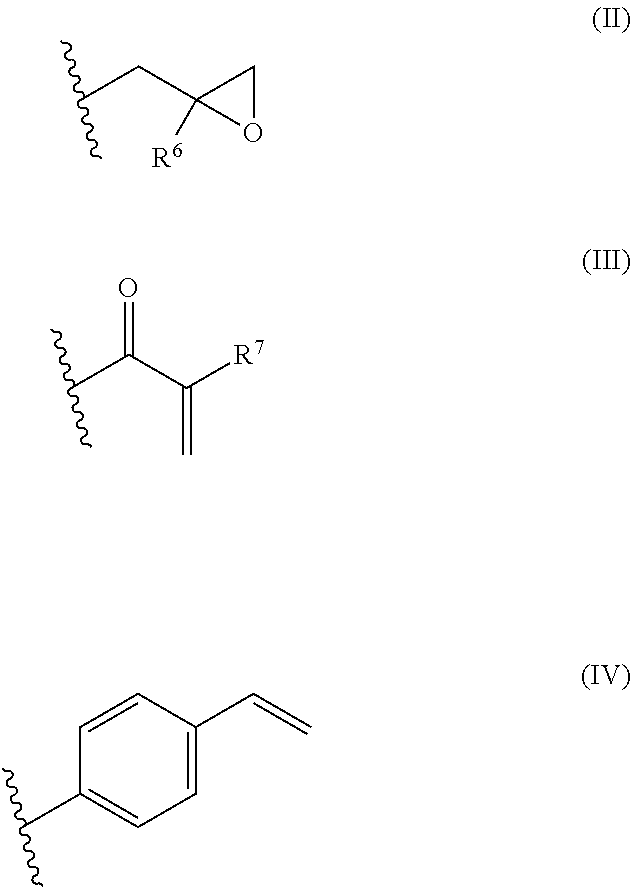Oxygen absorbing agent
a technology of oxygen absorption agent and resin composition, which is applied in the direction of organic chemistry, dispersed particle separation, separation process, etc., can solve the problems of slow curing and sticky surface, and achieve the effect of sufficient effect, and high oxygen absorption ability
- Summary
- Abstract
- Description
- Claims
- Application Information
AI Technical Summary
Benefits of technology
Problems solved by technology
Method used
Image
Examples
production example 1
[Production Example 1] Synthesis of 1-(3-methyl-2-butenoxy)-2,3-epoxypropane
[0037]
[0038]Into a reactor equipped with a stirrer, a thermometer, and a dropping funnel, 324 g (3.77 mol) of 3-methyl-2-buten-1-ol, 2,300 mL of cyclohexane, 226 g (5.65 mol) of sodium hydroxide, 15.2 g (37.3 mmol) of trioctylmethylammonium chloride, and 226 mL of purified water were put under nitrogen flow. While the inner temperature was kept at 25° C. or lower, 590 mL (7.54 mol) of epichlorohydrin was added dropwise with stirring over 90 minutes, and after completion of the dropwise addition, the temperature was raised to 40° C. over 30 minutes. The mixture was stirred at the inner temperature of 40° C. for 3 hours, and then was cooled to 25° C. The upper layer of the reaction liquid was washed five times with 670 mL of a saturated saline solution, and the organic layer was dried over sodium sulfate. Sodium sulfate was filtered out, and the filtrate was concentrated to obtain 536 g of a concentrate. The c...
production example 2
[Production Example 2] Synthesis of 1-(2-butenoxy)-2,3-epoxypropane
[0040]
[0041]Into a reactor equipped with a stirrer, a thermometer, and a dropping funnel, 54.5 g (755 mmol) of 2-buten-1-ol, 230 mL of cyclohexane, 45.2 g (1.13 mol) of sodium hydroxide, 3.0 g (7.42 mmol) of trioctylmethylammonium chloride, and 53 mL of purified water were put under nitrogen flow. While the inner temperature was kept at 25° C. or lower, 118.2 mL (1.51 mol) of epichlorohydrin was added dropwise with stirring over 120 minutes, and after completion of the dropwise addition, the temperature was raised to 40° C. over 30 minutes. The mixture was stirred at the inner temperature of 40° C. for 5.5 hours, and was then cooled to 25° C. The upper layer of the reaction liquid was washed three times with 130 mL of a saturated saline solution, and the organic layer was dried over sodium sulfate. Sodium sulfate was filtered out, and the filtrate was concentrated to obtain 124 g of a concentrate. The concentrate was...
example 1
[0043]Into a glass sample bottle, 10 g (70 mmol) of 1-(3-methyl-2-butenoxy)-2,3-epoxypropane and 56 mg (0.08 mmol; 0.11% by mol based on 1-(3-methyl-2-butenoxy)-2,3-epoxypropane) of cobalt(II) stearate (Wako Pure Chemical Industries, Ltd.; purity 90%) were put, and the mixture was stirred thoroughly to obtain an oxygen absorbing agent. The evaluation results are shown in Table 1.
PUM
| Property | Measurement | Unit |
|---|---|---|
| temperature | aaaaa | aaaaa |
| temperature | aaaaa | aaaaa |
| temperature | aaaaa | aaaaa |
Abstract
Description
Claims
Application Information
 Login to View More
Login to View More - R&D
- Intellectual Property
- Life Sciences
- Materials
- Tech Scout
- Unparalleled Data Quality
- Higher Quality Content
- 60% Fewer Hallucinations
Browse by: Latest US Patents, China's latest patents, Technical Efficacy Thesaurus, Application Domain, Technology Topic, Popular Technical Reports.
© 2025 PatSnap. All rights reserved.Legal|Privacy policy|Modern Slavery Act Transparency Statement|Sitemap|About US| Contact US: help@patsnap.com



